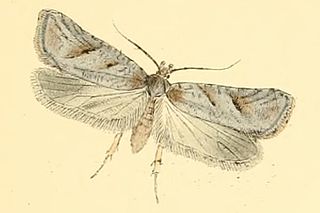Related Research Articles

Exaeretia allisella is a moth of the family Depressariidae. It is found in most of northern and central Europe, Siberia, the Russian Far East, Mongolia and northern and central China.

Exaeretia is a moth genus of the superfamily Gelechioidea. It is placed in the family Depressariidae, which is often – particularly in older treatments – considered a subfamily of Oecophoridae or included in the Elachistidae.
Exaeretia lutosella is a moth of the family Depressariidae. It is found in Ukraine, Romania, the Republic of Macedonia, Croatia, Italy, France, Spain, Portugal, Turkey, Palestine, Syria and Morocco.
Exaeretia nigromaculata is a moth of the family Depressariidae. It is found in Greece, Turkey and western Tajikistan.

Exaeretia praeustella is a moth of the family Depressariidae. It is found in Sweden, Finland, the Baltic region, Ukraine, Russia and Mongolia.
Exaeretia fulvus is a moth in the family Depressariidae. It was described by Lord Walsingham in 1882. It is found in North America, where it has been recorded from New Brunswick and Maine to British Columbia, south to Arizona and New Mexico.
Exaeretia gracilis is a moth in the family Depressariidae. It was described by Lord Walsingham in 1889. It is found in North America, where it has been recorded from North Dakota to Texas and in California, Colorado, Minnesota, Oklahoma, Wisconsin and Iowa.
Exaeretia hildaella is a moth in the family Depressariidae. It was described by John Frederick Gates Clarke in 1941. It is found in North America, where it has been recorded from Alberta and the Northwest Territories.
Exaeretia indubitatella is a moth in the family Depressariidae. It is found in Mongolia and Russia.
Exaeretia nechlys is a moth in the family Depressariidae. It is found in North America, where it has been recorded from Arizona to California and in Nevada.
Exaeretia nivalis is a moth in the family Depressariidae. It is found in North America, where it has been recorded from Montana, Wyoming, Washington, British Columbia and Alberta.
Exaeretia scabella is a moth in the family Depressariidae. It is found in North America, where it has been recorded from Ohio.
Exaeretia sordidella is a moth in the family Depressariidae. It is found in North America, where it has been recorded from British Columbia, Oklahoma and Texas.
Exaeretia thoracefasciella is a moth in the family Depressariidae. It is found in North America, where it has been recorded from California to Washington.
Exaeretia thoracenigraeella is a moth in the family Depressariidae. It is found in North America, where it has been recorded from California and Oregon.
Exaeretia umbraticostella is a moth in the family Depressariidae. It is found in North America, where it has been recorded from South Dakota and British Columbia to Texas and California.
Exaeretia relegata is a moth in the family Depressariidae. It was described by Edward Meyrick in 1920. It is found on the Juan Fernandez Islands.
Exaeretia amurella is a moth in the family Depressariidae. It was described by Alexandr L. Lvovsky in 1990. It is found in southern Siberia, Buryatia, Transbaikalia and northern Mongolia.
Exaeretia kozhantshikovi is a moth in the family Depressariidae. It was described by Alexandr L. Lvovsky in 2013. It is found in central Russia (Krasnoyarsk).
Exaeretia vladimiri is a moth in the family Depressariidae. It was described by Alexandr L. Lvovsky in 1984. It is found in Turkmenistan, southern Kazakhstan and southern Uzbekistan.
References
| This article on a moth of the subfamily Depressariinae is a stub. You can help Wikipedia by expanding it. |